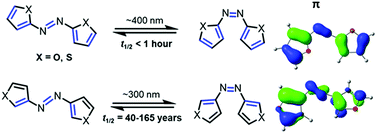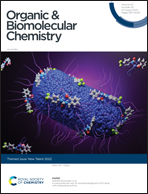Cross-conjugation controls the stabilities and photophysical properties of heteroazoarene photoswitches†
Abstract
Azoarene photoswitches are versatile molecules that interconvert from their E-isomer to their Z-isomer with light. Azobenzene is a prototypical photoswitch but its derivatives can be poorly suited for in vivo applications such as photopharmacology due to undesired photochemical reactions promoted by ultraviolet light and the relatively short half-life (t1/2) of the Z-isomer (2 days). Experimental and computational studies suggest that these properties (λmax of the E isomer and t1/2 of the Z-isomer) are inversely related. We identified isomeric azobisthiophenes and azobisfurans from a high-throughput screening study of 1540 azoarenes as photoswitch candidates with improved λmax and t1/2 values relative to azobenzene. We used density functional theory to predict the activation free energies and vertical excitation energies of the E- and Z-isomers of 2,2- and 3,3-substituted azobisthiophenes and azobisfurans. The half-lives depend on whether the heterocycles are π-conjugated or cross-conjugated with the diazo π-bond. The 2,2-substituted azoarenes both have t1/2 values on the scale of 1 hour, while the 3,3-analogues have computed half-lives of 40 and 230 years (thiophene and furan, respectively). The 2,2-substituted heteroazoarenes have significantly higher λmax absorptions than their 3,3-substituted analogues: 76 nm for azofuran and 77 nm for azothiophene.

- This article is part of the themed collections: New Talent and Mechanistic, computational & physical organic chemistry in OBC


 Please wait while we load your content...
Please wait while we load your content...